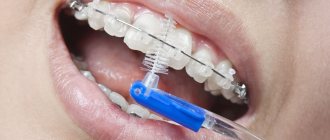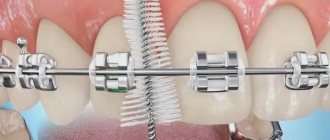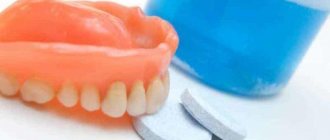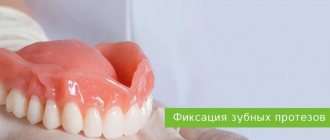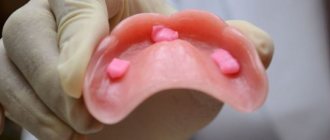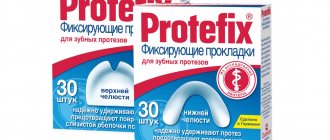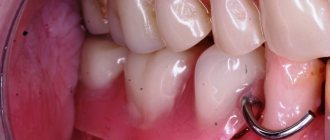If a person has problems with teeth located in the smile area, then he may experience discomfort and be unsure of himself. Prosthetics of the front teeth, which will be indistinguishable from natural units with the correct choice of materials and treatment methods, will help correct the situation. The modern dental clinic “World of Dentistry” offers prosthetics services. Our professional dentists will perform the procedure quickly and efficiently, using the best certified materials and techniques.
Correction of an incorrectly manufactured complete denture base
During the delivery of complete dentures, errors are possible, caused in some cases by incorrect determination of the central relationship of the jaws or violations in the process of laboratory production of dentures, in others - by incorrect determination of the lower third of the face or the boundaries of the prosthetic field.
However, one of the most serious and most common disadvantages of complete dentures is their poor fit. The tissues under such prostheses are often subject to mechanical trauma, which leads to pathological changes. The reasons for poor fixation of complete dentures are: shortened or elongated edges of the denture base; discrepancy between the base of the prosthesis and the relief of the hard palate or alveolar process of the lower jaw; lack of space for the torus palatinus and other bony protrusions; the tissue of the soft palate is not pressed upward with an individual spoon before and during the impression; anatomical formations on the lower jaw (sublingual and retroalveolar spaces, mandibular tubercles) are not used to hold the lower denture; the edges of the prosthesis do not correspond to the edges of the obtained functional impression; poor quality prints; the edges of the prosthesis cover the frenulum and folds; there is not enough space for the free functioning of the language, etc.
Heringer compasses
If the edges of the prosthesis are elongated, then hyperemia appears in places of increased pressure, and then pressure sores occur. In this case, during contraction of the muscles on which the edges of the prosthesis are located, the prosthesis is displaced from its bed.
Correction of the prosthesis should be made when hyperemia appears, since subsequently, when bedsores form, accompanied by pain and inflammatory infiltration of surrounding tissues, the boundaries defining the area of the elongated edge of the prosthesis are erased.
To accurately determine the elongated boundaries of the prosthesis, dentin or gypsum powder is applied to the hyperemic areas and the prosthesis is applied to the jaw. The areas marked on the prosthesis with white powder are the places of correction. If the edges of the prosthesis are shortened, they are lengthened with wax, formed in the patient’s mouth, and the wax is replaced with plastic.
Functional overload of teeth
M.A. Napadov and V.Yu. Kurlyandsky (1955) recommend correcting the base of the prosthesis and its edges directly in the patient’s mouth using quick-hardening plastic. There are other ways to reline dentures. However, using them, we did not always obtain satisfactory results.
The following method of correcting the base of the prosthesis on the lower jaw turned out to be more reliable.
Using fast-hardening plastic, areas of the prosthesis extending into the retroalveolar and sublingual spaces are supplemented, and if the base is narrowed, it is expanded from the vestibular side in the area of the lateral teeth. Excess plastic on the inner surface of the prosthesis base, which restricts the movements of the tongue, is cut off, and a recess is made between the molars and premolars on the vestibular surface of the prosthesis base for applying a retainer. After this, an orthocore plate is applied to the base of the prosthesis, the edges of which end on the vestibular and lingual surfaces. Excess orthocore is cut off in such a way as to form a smooth transition to the base of the prosthesis. Orthocor is heated in hot water, the prosthesis is placed on the lower jaw and secured with a retainer. Then the patient is asked to carry out the full range of chewing, swallowing and other functional movements, as well as to make phonetic correction of the edges of the prosthesis. In areas where the edges of the prosthesis are exposed, the latter are shortened, covered again with orthocor and reinserted into the oral cavity. Having completed the correction, the prosthesis is plastered into a ditch and the orthocor is replaced with plastic in the laboratory. The finished prosthesis is handed over to the patient and the dentition is corrected under the control of carbon paper, achieving smooth gliding of the dentition.
Anatomical articulator design and model fixation technique
If the complete upper denture is poorly fixed, then the cause of poor fixation is determined. If the posterior edge of the prosthesis is located 2-3 mm posterior to the blind foramina and overlaps them, it should be assumed that the soft palate was not pressed upward when taking a functional impression. In this case, a narrow strip of heated wax is placed on the back edge of the prosthesis, and the tissue of the soft palate is pressed out with it. As a result, the prosthesis begins to stick, which confirms the correctness of the assumption made.
In cases where the prosthesis does not cover the blind holes, its posterior edge is lengthened. For this purpose, the wax plate is heated and folded into 2 layers so that the upper one is a continuation of the prosthesis, and the lower one extends to its surface facing the oral cavity. The wax plate is fixed to the prosthesis using a heated spatula. The prosthesis is inserted into the oral cavity and the wax part is pressed upward on the soft palate, cooled in water and reinserted into the oral cavity. If the prosthesis begins to stick, it should be assumed that its posterior edge has been shortened. If, when you press your fingers on the front teeth, the prosthesis is well fixed on the jaw, this means that its rear edge not only properly presses the soft palate upward, but also has a sufficient length.
A.I. Betelman and co-authors (1954) recommend marking the posterior border of the prosthesis on the soft palate with a blue pencil, getting a pencil imprint on the back of the prosthesis and cutting off excess wax outside the valve area. If using wax it was possible to eliminate the cause of poor fixation, the prosthesis is plastered in a ditch, the wax is replaced with plastic and the prosthesis is given to the patient.
If using the described manipulations it was not possible to improve the fixation of the prosthesis, the back side is covered with a heated strip of wax, it is strengthened and, after heating the wax strongly on an alcohol lamp, the prosthesis is inserted into the patient’s mouth. Holding the prosthesis on the jaw, the patient is asked to functionally design its edges. After clarifying the boundaries of the prosthetic field 2-3 times and cooling in water, the prosthesis should stick, as a valve will form under it. However, in some cases this does not happen, and the prosthesis, at the slightest tension of its soft tissues, begins to “slide” from the jaw. Consequently, the excessively elongated sides of the prosthesis are located much above the neutral zone on the moving soft tissues. In these cases, it can be difficult to correct the denture by shortening its sides using wax. Sometimes more serious deficiencies cannot be eliminated at all, and the prostheses must be remade.
How to quickly restore beauty to your teeth
Metal-ceramics, from which crowns are installed on the front teeth, are made in the traditional way with an impression. And prostheses made of ceramic or zirconium can be obtained in just 1.5 hours using Cerek technology. One anesthesia will be required, or you can do without it. The prosthesis is installed on a fresh, just prepared surface.
The technology is relevant for the production of metal-free crowns:
- The problem area is scanned and the model is reproduced by a computer.
- The anatomical dimensions and shape will exactly repeat the “native” tooth.
- The program will create a model and send the job to the grinding unit, where the design will be created.
If the shade is slightly different from the desired one, a new ideal copy can be easily created. A single crown is installed or an option is created for two front teeth.
Which removable dentures are better for the lower jaw?
Not all orthopedic solutions are equally effective for installation on both jaws, because each of them has its own distinctive features. The individual characteristics of the lower jaw largely determine the choice of a specific design model, since other dentures can cause discomfort or be poorly fixed in the oral cavity. Let us consider the features of choosing dentures for the restoration of the lower dentition.
Features of lower jaw prosthetics
Removable structures can be used both in case of partial or complete absence of all teeth in the lower jaw. Considering its main distinctive features, it is worth paying attention to the following anatomical characteristics:
- high level of bone tissue density and slower bone resorption after tooth extraction - the prosthesis is therefore better fixed, since the gums together with the bone tissue sag less,
- the bone tissue is larger in height than in the upper jaw,
- the presence of frenulums under the tongue reduces the strength of the product’s fixation and causes some discomfort during its use,
- due to pressure from the cheeks and tongue, the structure moves, which makes the prosthesis less comfortable,
- There are fewer requirements for the aesthetics of the orthopedic device, but more for its functionality.
Restoring the integrity of the lower row involves some difficulties due to the location of the tongue and its articulation. The choice of a specific prosthesis model is also directly related to the number of remaining teeth in the row.
Prosthetics
Prosthetics with complete edentia
Clasp dentures cannot be used with complete edentia, so in this case the optimal choice is the Quattro Ti design. Many experts classify this model as a clasp type, but it is based on no metal elements that could injure the enamel and gums. In addition, such a prosthesis can be used with complete edentia - it can only be fixed on the gums.
Another good option is Akri Free dentures, which meet high demands on aesthetics and durability. As for acrylic solutions, when restoring the lower row in the absence of all teeth, the fixation of the apparatus will be rather weak. As an alternative, you can resort to conditionally removable prosthetics using an acrylic device supported by implants.
Let us quote D. Jerryson, a professor at New York University College of Dentistry, who specializes in research in the field of dental prosthetics: “When choosing a specific model of removable denture, it is necessary to take into account the clinical picture as a whole. If Quadrotti is a universal option, then clasp solutions can be fixed only if there are supporting elements of the dentition. Among the less convenient but budget options, it is worth highlighting acrylic dentures, but the final choice can only be made by a qualified specialist after conducting an appropriate examination.”
Next, we will consider in detail the types of modern orthopedic systems that are most often chosen to restore both part of the teeth and the entire dentition in the lower jaw.
Methods of prosthetics of the anterior upper units
- Veneers. They are thin porcelain plates with a shade completely similar to the color of natural teeth. Veneers are made to fit the contour of the patient’s teeth, so they fit him perfectly. Thin plates are installed on the front of the units and solve the following problems:
- Filling interdental gaps.
- Leveling tooth enamel.
- Concealing dark spots and yellowed tooth enamel.
- Masking cracks and chips.
- Alignment of teeth.
Veneers can be:
- Composite (direct) - the veneer material is applied and formed directly on the tooth.
- Ceramic (indirect) – made from pre-made impressions of the patient’s teeth, formed in the laboratory, and then attached to the teeth. Ceramics has high aesthetic properties and is as similar in appearance and properties as natural tooth enamel.
- Lumineers. These are ultra-thin veneers, the thickness of which is only 0.2 mm. Considering the fact that lumineers are installed without grinding the tooth enamel, they do not always fit tightly and have a risk of coming off. The disadvantage of lumineers is the fact that the teeth covered with them protrude slightly forward compared to units without dentures. Therefore, when prosthetics is applied to one tooth, it will stand out strongly against the background of the rest of the units.
Lumineers and veneers have the following advantages:
- Painless installation.
- Long service life.
- The prosthetic procedure takes little time.
- Lumineers can be installed without grinding the enamel.
- Teeth under veneers and lumineers are protected from the harmful effects of oral microorganisms.
- Crowns. Artificial crowns are installed in cases where teeth are severely damaged. Such dentures allow you to preserve the tooth root. In this case, before prosthetics, the specialist carries out the necessary treatment of the affected tooth. Under the crown, the remaining part of the dental unit will remain intact. The crowns are fixed with special dental cement.
- Dental bridge. This design allows you to simultaneously restore several lost teeth in a row. A bridge is a structure consisting of a false tooth sandwiched between two dental crowns. These crowns are placed over the teeth on either side of the gap and are secured. The benefit of dental bridges is that they prevent surrounding teeth from shifting.
Options for removable orthopedic solutions for the lower jaw
Clasp dentures
Currently, a clasp denture is one of the best solutions for partial restoration of teeth. The design involves the presence of a strong metal arch, to which a light pink base made of nylon or plastic is attached, and artificial crowns are fixed on it. There is no bulky overlap in the sublingual area, but only a thin arc that is practically not felt, and certainly does not affect comfort and taste in any way.
“So, I’ll tell you about my impressions of the clasp prosthesis. Before him, I went with nylon and it was terrible. Unlike its predecessor, the clasp version on the lower jaw is much more convenient. At first there were minor problems with diction, but these were minor things, I just had to get used to it. The denture stays firmly in the mouth, does not interfere with eating and talking, and does not emit an unpleasant odor. Excellent solution, of course, if you are not allergic to metal. By the way, I don’t feel any metallic taste either.”
Alena Shep, Moscow, review from flamp.ru
The main advantages of this type of prosthesis include increased strength and a short adaptation period. The convenient design allows you to evenly distribute the load when chewing, and is characterized by the absence of overlap in the sublingual area, which significantly increases the level of comfort. Among the disadvantages are the relative level of aesthetics due to the presence of metal fasteners, the need to prepare abutment teeth, as well as the high cost when choosing a model with attachments. In addition, this option is not suitable if we are talking about the absence of all teeth.
Clasp denture with locks
The clasp version with clasps will cost from 20 thousand rubles, while the model with micro-locks will cost significantly more - from 50 thousand. This cost usually includes payment for materials and specialist work.
Quadrotti dentures
Quadrotti is based on the soft elastic material Dental D. Thanks to its properties, it copes well with high loads, does not cause allergic reactions, and is also simple and easy to process. Dentures made from Dental D do not contain hard metal parts, which not only interfere with aesthetics, but also cause a lot of inconvenience. The material is fully validated by clinical studies conducted throughout the world over the past ten years 1 .
“In my opinion, Quadrotti is greatly overrated. No, the prosthesis is comfortable, you can’t argue with that, but I definitely haven’t had anything like that, just WOW. Before this I went with a clasp apparatus and now I don’t feel much difference. While I’m still in the period of getting used to it, it’s still a little difficult to speak, and even more so to chew. They promised that there would be no discomfort, but the artificial gum still rubs a little. Otherwise, the option is good, it looks, at least, very natural.”
Irina L., Perm, review from otzovik.com
The advantages of this model include excellent aesthetic characteristics, strength of fixation, and minimal risk of developing allergies. Such dentures are very comfortable and durable. Additionally, they can be flavored with chocolate, vanilla or citrus flavors. Among the disadvantages of Quadrotti are the high cost of the device, as well as the need for regular relocation of the prosthesis.
Quadrotti on the lower jaw
On average, the cost of manufacturing and installing a Quadrotti prosthesis for one lower jaw is 40 thousand rubles. The amount includes the cost of materials and payment for the work of specialists.
Acrylic prosthesis
Acrylic structures for partial tooth replacement are equipped with hard clasps, which often rub and can injure soft tissues and oral mucosa. This solution cannot be called convenient, but it often becomes the best choice when the patient is financially limited. With complete edentia, these dentures are fixed quite well. Moreover, their cost is from 15 thousand rubles.
How much do the best dentures cost?
| Construction type | Price |
| Crowns | From 12,000 rubles for metal ceramics to 40,000 for zirconium crowns |
| Veneers | 20,000 – 25,000 rubles per unit |
| Partial denture on implants | From 70,000 rubles |
| Classic bridge | On average 8,000 – 15,000 rubles |
| Complete denture on implants | 150,000 – 600,000 rubles for one jaw. Depends on the number and brand of implants implanted. |
| Butterfly prosthesis | From 4,000 rubles depending on the material |
| Plate dentures | From 20,000 rubles. 30,000 – 35,000 rubles for Quadrotti prostheses |
| Removable complete denture | On average 35,000 rubles for a full Acry Free prosthesis |
| Removable denture on mini-implants | 100,000–120,000 rubles for one jaw |
Publisher: Expert magazine about dentistry Startsmile.ru
An alternative solution is implantation.
Any model of removable denture is not able to stop the process of bone tissue atrophy, which inevitably follows tooth extraction. The only option that can protect against atrophy is dental implantation, which allows you to preserve the existing volume of bone tissue. Using this technique, you can restore not only the crowns, but also the roots of the teeth, as well as the full functioning of the jaw system.
Video review from a patient about lower jaw implantation after long-term wearing of a removable denture
Possible consequences
The longer a patient uses a prosthesis characterized by an unstable position, the more serious the consequences for his health may be. Potential complications include:
- Constant physical and psychological discomfort associated with displacement of the structure while eating or communicating with others;
- Damage to the oral mucosa caused by rubbing or biting;
- Impaired diction, as well as distortion of natural facial proportions;
- Regular entry of food particles into the area between the prosthesis and the base, which results not only in the formation of pathogenic microflora, but also in disorder of the digestive system;
- Possibility of failure of the replacement structure;
- The need for constant adjustment of the position of the removable denture.
In such a condition, it is difficult to talk about restoring the aesthetics and functionality of the jaw, therefore, at the first signs of a fixation disorder, it is recommended to contact your dentist.
Reasons for poor fixation
- Incorrect fit of the prosthesis initially;
- Over time, the size of the gum and jaw have changed;
- Prosthesis care violations.
In rare cases, it happens that even a fixed prosthesis begins to wobble. The reason is that the cement on which the crown was fixed may lose its strength after a few years. In this case, you should immediately contact a specialist who knows how to fix the denture without damaging it. The crown can be carefully removed and reinstalled with new cement. More often, this problem affects those who installed crowns many years ago. Modern cement for fixing the prosthesis is much more durable.
Consequences of a loose prosthesis
Dentures are installed in order to restore the dentition, restore the previous functionality for high-quality chewing of food, and restore the beauty of the smile. The best solution is to install fixed dentures and implants. But sometimes you cannot do without removable, conditionally removable dentures. A well-installed structure is reliable and does not require grinding of adjacent teeth, which is one of the biggest advantages. However, a poorly installed prosthesis leads to many serious problems;
- Constant rubbing of the gums, which can even develop into cancer;
- Distortion of speech and even facial expressions;
- Pieces of food getting under the prosthesis, which leads to inflammatory processes;
- Accidental loss of the prosthesis during a conversation or even during sleep;
- Psychological stress leading to decreased self-esteem and the emergence of self-doubt.
If your denture becomes loose in the first days after installation, you should discuss this with your doctor. Perhaps there are anatomical features that make it difficult for the doctor to achieve ideal fixation of the prosthesis. However, in many cases it is possible to improve fixation through adjustment.
Telescopic crowns
They are more expensive compared to others. The supporting teeth are ground down and a much smaller crown is placed on them. The entire structure is installed on them, which holds tightly thanks to perfectly fitted shapes.
The points described above describe how removable dentures are attached to the presence of supporting living teeth. But how is a denture attached if there are no teeth?
What to do?
- Contact a specialist for advice and help;
- Adjust the design or order a new one;
- Find another prosthetic option.
In general, each specific case has its own individual solution. For example, if teeth are completely missing, you can use acrylic or nylon dentures. They are perfectly attached due to vacuum, sticking to the gums. A high-quality prosthesis does not require the use of special creams. However, in patients with atrophied bone tissue, when moving the jaw, air can get under the prosthesis, breaking the vacuum. In this case, two implants are placed, and the structure is held securely.
If not all teeth in the mouth are lost, but the upper denture, which is conditionally removable, does not hold, there is a solution for this too. Such designs can be plate, nylon, or clasp. They are fixed with clasps, hooks, and gingival processes. If the structure is unstable, you just need to tighten the fastening. But you can’t do it yourself, you might accidentally break it. You can only trust the work to a doctor.
Types of removable dentures in complete absence of teeth
Plate acrylic
Classic acrylic insert jaws are made of hard plastic. Fixation is ensured by a wide lamellar base. When biting, air comes out from under the base and a suction effect occurs. Pros: affordable price, maintainability, aesthetics. The disadvantages include deterioration of fixation as the contours of the prosthetic bed change with the need for relining, large sizes, and the need to adapt to the device. Plastic contains monomers that can cause allergies. Artificial teeth absorb dyes and odors, and after 2-3 years they lose their aesthetic properties.
Acry-Free
Monomer-free plastic Acri Free, produced in Israel, is more elastic than acrylic and does not cause allergies. Products from it are made using the injection molding method, which ensures precise fit of the base to soft tissues, as well as tight fixation. The compactness and translucency of the artificial gum make the false jaw convenient, comfortable, and aesthetically pleasing. The resistance of the structure to chewing loads prevents damage to soft tissues and also somewhat slows down atrophy. Orthopedic devices from Akri-Free are recognized as the best alternative to plastic false jaws, but they cost more.
Nylon
The main characteristic of the material of nylon prostheses is elasticity. The base is thinner, softer, and more compact than plastic, which makes false teeth comfortable for the patient. The translucency of the base ensures aesthetics. However, softness is also a disadvantage of nylon. The base quickly loses its shape, which negatively affects fixation. The device cannot be repositioned. During chewing of food, the load is not distributed, but is locally transferred to soft tissues, which causes pain in patients. The porous material absorbs dyes and changes the smell.
How to manage without dentures?
Alas, you cannot do without prosthetics. The loss of even one tooth disrupts the harmony in the oral cavity. In place of a lost tooth, the skin becomes less elastic, the correct oval of the face is lost over time, and signs of aging appear. The load on the remaining teeth increases. The jaw bone becomes thinner and the gum structure changes.
After tooth extraction, less blood flows into this area of tissue, and the number of blood vessels in the area where the tooth is missing decreases. As a result, the structure of the jaw bone is disrupted. All these processes then lead to displacement of the dentition, to an incorrect bite. And this, in turn, affects the quality of chewing food and disrupts the digestion process.
Even a person’s speech is impaired. Due to the absence of individual teeth, it is impossible to pronounce some sounds correctly. Especially if the problem affects the front teeth. Moreover, the absence of the front row of teeth leads to changes in the nasolabial fold. It lengthens, the corners of the mouth droop, and the person begins to look older than his age.

